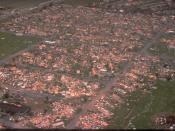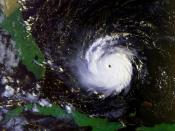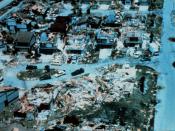Hurricane Andrew Andrew was a small and devastating Cape Verde hurricane that brought never before seen economic destruction along a path through the northwestern Bahamas, the southern tip of Florida, and south central Louisiana. Damage in the United States is averaged to be near 25 billion, making Andrew the most expensive hurricane in US history. The storm struck southern Dade County, Florida, the hardest with violent winds and storm surge on the level of a class 4 hurricane. Andrew had a pressure that is the third lowest this century for a hurricane at landfall in the US. In Dade County alone, the forces of Andrew resulted in 15 deaths and up to 250 thousand people left temporarily homeless. An additional 25 lives were loss in Dade County from the following results of Andrew. The direct loss of life seems to be really small considering the destruction caused by this hurricane.
Satellite pictures and upper-air data indicated that Hurricane Andrew formed from a tropical wave that crossed from the west coast of Africa to the tropical North Atlantic on the 14th of August, 1992. The wave moved forward at about 20 miles per hour, driven by the deep easterly current on the south side of an area of high pressure. The wave passed to the south of the Cape Verde Islands on the following day. At that point, meteorologists found the wave adequately developed to begin classifying the intensity of the system.
Precipitation became more focused in a region of cloud rotation. Narrow spiral-shaped bands of clouds developed around the center of rotation on the 16th of August. At 6:00 p.m. on the 16th, Andrew became a tropical depression.
By midday on the 17th at 12:00 p.m. the depression grew stronger and became the first Atlantic tropical storm of the...


